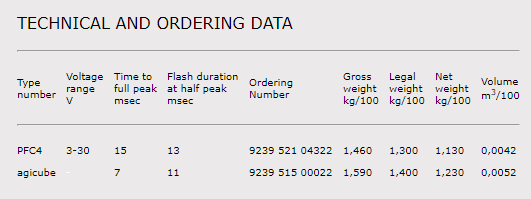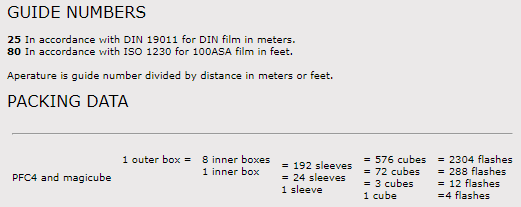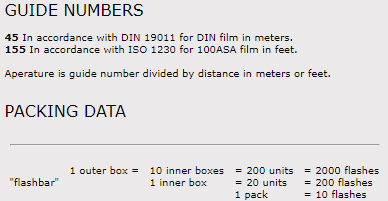Information
Philips Flashbulbs
Cress Photo has a vast inventory of Philips flashbulbs. Below you will find information pertaining to the different types alongside images, technical specifications, order data and guide numbers. You can navigate to the different sections by flashbulb type using the menu to the right.
Guide Numbers shown are in meters
from 1955, 1970 & 1976 Catalogs
``PHOTOFLUX`` FLASHBULBS
The modern camera-owner is making ever-increasing use of flashbulbs.
Philips "Photoflux" bulbs are the ideal light sources for exposures of fast-moving subjects or candid shots. They are indispensable for both indoor and outdoor photography - when there is little or no daylight or, in bright weather, to diminish the sharp contrast between the sun-lit areas and dark shadows. "Photoflux" bulbs make every camera-owner independent of time, place, and weather. With this never-failing aid he can be sure that every shot turns out a winner.
BASELESS TYPES
Technical developments have led to the manufacture of a series of small baseless flashbulbs of a high luminous intensity.
Type AG3B is available with a blue coating carefully matched to the colour characteristics of daylight-type colour films but it can be used equally well for black-and-white photography.
In case they are required for particular reasons, AG1 and AG1B are still available.

PF 1 B & BF 5 B
Other types of small baseless flashbulbs, the PF1B and PF5B, are specially designed for PF-type flashguns.
These blue "Photoflux" flashbulbs which possess the same excellent qualities as the bulb described above, are intended for use with both daylight colour and black-and-white materials.

See Also type PF 6 B
Flashcube | PFC4
This flash unit contains 4 blue flashbulbs, each with its own individual reflector. The unit permits the photographer to take 4 flash pictures in very rapid succession.
Cameras adapted to this unit are available on the market as well as various types of adapters to enable the flash unit to be used on older-type cameras

PF 60 E and PF 60 E/97
The modern camera-owner is making ever-increasing use of flashbulbs.
Philips "Photoflux" bulbs are the ideal light sources for exposures of fast-moving subjects or candid shots. They are indispensable for both indoor and outdoor photography - when there is little or no daylight or, in bright weather, to diminish the sharp contrast between the sun-lit areas and dark shadows. "Photoflux" bulbs make every camera-owner independent of time, place, and weather. With this never-failing aid he can be sure that every shot turns out a winner.
CLASS M
Class M flashbulbs have been specially designed for cameras having between-the-lens shutters. They can be used with the "open-flash" method as well as with cameras having built-in synchronization. They are also available witha blue filter lacquer for colour photography.

PH 100 E & Ph 100 E/97
Designed also for use with cameras equipped with between-the-lens shutters, the PF 100E and PF 100E/97 flashbulbs have a greater luminous intensity than other "Photoflux" bulbs and are, therefore, specially suitable for large area coverage. They are intended for the "open-flash" method of photography.
Cameras adapted to this unit are available on the market as well as various types of adapters to enable the flash unit to be used on older-type cameras

PF 6 B & PF 45 E & PF 45 E/97
CLASS FP
Due to their relatively long flash duration at half peak, these types are specifically destined to be used with cameras with focal-plane shutters.

PF1B & AG3B
The PF1B and AG3B flashbulbs are to be used in separate flash units. Some older types of camera have a bult-in reflector for use with the AG3B. Both bulb types are suitable for use with all black-and-white and colour films, including instant film.
Cameras adapted to this unit are available on the market as well as various types of adapters to enable the flash unit to be used on older-type cameras
Photoflux Flashbulbs M Class
Photography today would be absolutely inconceivable without the flashlight that is produced by flashbulbs. Over 20 years ago, Philips introduced the first "Photoflux" flashbulb and from that time onwards the name "Photoflux" stood for quality and reliability. Philips research always went forward to produce better flashbulbs, supplying more light and taking less space and we dare to say that more and new important developments lie ahead.
The program now available comprises 10 different types, all made with the famous Philips accuracy.
These flashbulbs are suitable for between-the-lens shutters, they can be used with the open flash method as well as for cameras with built-in synchronization. For colour photography these lamps are available with a special blue filter lacquer. When ordering no. 97 is to be added to the type number of the clear type.

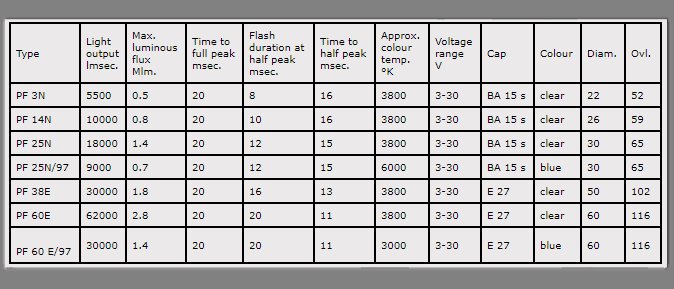

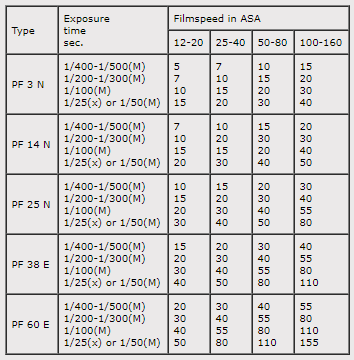
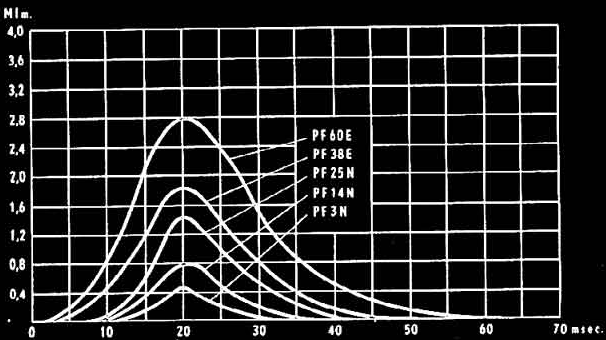
Photoflux Flashbulbs PF 100 E
This bulb has been specially designed for photographing with the open-flash method and is very suitable for covering large areas. For colour photography, this type is available with a special blue filter lacquer.
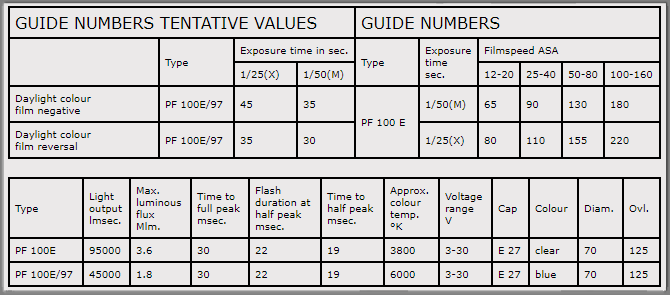
FP Type Shutters
Synchronized flash photography with focal-plane shutters calls for lamps with long flash duration of the types shown here. The PF 24 type may be used with miniature cameras such as the Leica and the Contax, which feature a shutter of very short traveling time.
Cameras adapted to this unit are available on the market as well as various types of adapters to enable the flash unit to be used on older-type cameras
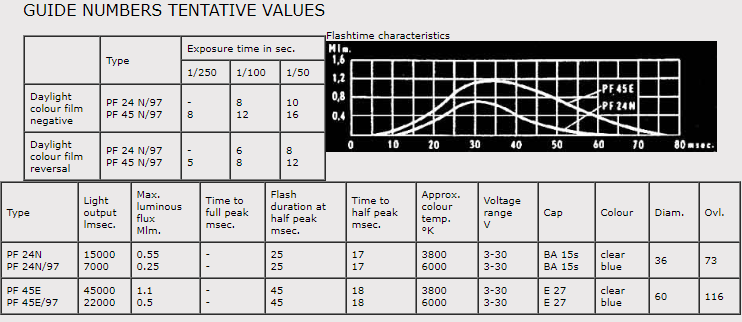
Capless ``Photolux`` Flashbulb PF1
THE LATEST DEVELOPMENT IN FLASHBULBS
Again, Philips are the first to introduce a revolutionary flashbulb, which will bring indoor photography within the reach of everybody.
The PF 1 capless "Photoflux" flashbulb together with adaptor is suitable for every existing flash gun. Compared to its small dimensions, it has a very high light output.
To insert the PF 1 in the existing flash guns a special adaptor is to be used. This adaptor carries a device to enable the user to remove the lamp without touching it.
Philips
Topflash
The 'topflash' is specially developed for use on pocket and instant cameras with piezo-electric ceramic cubes to provide the electrical
discharge needed for ignition of the bulbs.
The unit contains 8 hard-glass flashbulbs and a blue cover divided in two groups of 4 bulbs, each bulb with its own individual reflector.
The 'topflash' is shaped as a vertical array in which the top 4 bulbs will flash in a given sequence. Flashing the last lamp of a group
causes the appearance of a yellow dot.
As the 'topflash' is vertically mounted on top of the camera, the distance between the flash source and the lens opening is increased;
hence, the 'topflash' acts as its own extender and reduces the occurrence of red-eye to the minimum.
The 'topflash' is suitable for black-and-white and colour films, including instant film.
MULTIPLE FLASH
The ‘topflash’ features the unique possibility of simultaneous, multiple flash and is, therefore, the only non-electronic flash system that offers the possibility of adapting the light output to the flash distance. As under-exposed pictures are a frequent cause of disappointment amongst amateur photopraphers, simultaneous, multiple flash is an important advantage in those situations where a single bulb proves to be entirely inadequate.
By pressing the numbers on the ‘topflash’, up to four bulbs can be flashed simultaneously. This will enable the photographer to take well-exposed pictures, for instance at weddings, receptions, sport events or whenever a large area or many people form the subject of a picture.
PFC4 & Magicube
These flash units contain 4 blue flashbulbs, each with its own individual reflector. The PFC4 flash unit is used on instamatic, pocket, and instant cameras which carry a battery, needed for ignition of the flashbulbs. The magicube, however, developed for use on other series of instamatic and pocket cameras, does not require a battery for ignition. A flashbulb is fired mechanically by a striker which is released from its mounting in the base of the magicube by a percussion system built in the camera. Both the PFC4 and the magicube are suitable for use with all black-and-white and colour films, including instant film.
Flashbar
The "flashbar" contains 10 hafnium-filled, har-glass flashbulbs, each with its own individual reflector, divided in two groups of 5 bulbs. The two groups face in opposite directions, so that the bar has to be turned round after 5 flashes. The power needed for ignition is provided by a battery in the camera.
The "flashbar" is specially developed for use with some specific instant cameras and is therefore, suitable for all instant films used in these cameras.


